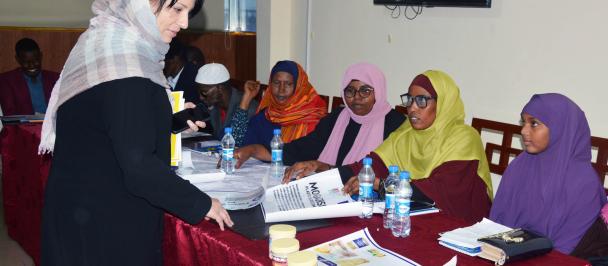UN Joint Programme on Youth Employment
Background
The Federal Government of Somalia and United Nations Joint Programme on Youth Employment aims to capitalise on recent security, governance and reconciliation achievements by expanding employment opportunities for young men and women in Somalia. As highlighted in the Economic Recovery Plan for Somalia, youth unemployment is one of the greatest obstacles to the country’s economic recovery. The plan states the aim of the government is to provide youth with employment opportunities so as to avoid the latter joining militia groups. This is to be achieved through vocational training, enterprise training and creation and rehabilitation of infrastructure through labour intensive employment methods. The programme recognizes the centrality of youth in fostering stability in the country and outlines specific interventions that can be taken within the next 18 months to begin to generate decent work opportunities for young people that will serve as positive alternatives to participation in violence and conflict. This will also contribute to the revitalization of the local economy. The employment generating interventions from this programme also aim to augment the credibility of the FGS and build trust and confidence in local governance and security sector institutions while providing immediate peace dividends to vulnerable sub-sections of the population.
Response
The main objective of the value chain component of the youth employment program is to improve the long-term potential for growth, productivity and employment of at least six value chains in the agriculture, fisheries livestock, construction and hospitality sectors. Given that the main cause of youth unemployment in Somalia appears to be a result of demand side factors, we need to focus at enterprises in the private sector that actually create jobs. Consequently, we need to improve the competitiveness of the sectors and companies, enhance the business environment, open the economy to trade, foster investment and growth, increase productivity, and – as a final outcome-- create sustainable jobs. It is thus important to better engage private sector companies and work with employers, associations and Chambers of Commerce, which are often insufficiently involved in the design of the programme. We also need to link up with existing private sector development programmes and the Economic Partnership for Somalia (USAID). The programme will also build on the Local Economic Development (LED) forum created by the on-going Joint Programme on Local Governance (JPLG). These LED forums are a platform for public-private dialogue and effective partnerships.
The programme will achieve the following outcome and sub-outcomes:
Somali economy revitalized and expanded with a focus on livelihood enhancement, employment generation, and broad-based inclusive growth.
Sub-Outcomes:
• Improved long-term potential for growth, productivity and employment by tackling the key constraints of six value chains in various sectors, including agriculture, fisheries and livestock, leading to 5,000 sustainable jobs.
• Enhanced longer-term employability of 20,000 youth (13,000 urban and 7,000 rural) through basic literacy, numeracy and life-skills and vocational and business training in sectors with high growth and employment potential.
• Rehabilitated productive infrastructure through short-term jobs for 30,000 youth (16,000 rural and 14,000 urban).

 Locations
Locations
